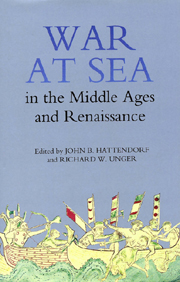Book contents
- Frontmatter
- Contents
- List of illustrations
- List of Contributors
- Preface
- Acknowledgements
- Introduction: Theories of Naval Power: A. T. Mahan and the Naval History of Medieval and Renaissance Europe
- I Northern Europe
- Naval Force in the Viking Age and High Medieval Denmark
- Scandinavian Warships and Naval Power in the Thirteenth and Fourteenth Centuries
- Naval Power and Maritime Technology during the Hundred Years War
- Oars, Sails and Guns: The English and War at Sea, c.1200–c.1500
- II Southern Europe
- III Sixteenth and Early-Seventeenth-Century Europe
- Conclusion: Toward a History of Medieval Sea Power
- Index
- Titles in the series
Oars, Sails and Guns: The English and War at Sea, c.1200–c.1500
from I - Northern Europe
Published online by Cambridge University Press: 05 April 2013
- Frontmatter
- Contents
- List of illustrations
- List of Contributors
- Preface
- Acknowledgements
- Introduction: Theories of Naval Power: A. T. Mahan and the Naval History of Medieval and Renaissance Europe
- I Northern Europe
- Naval Force in the Viking Age and High Medieval Denmark
- Scandinavian Warships and Naval Power in the Thirteenth and Fourteenth Centuries
- Naval Power and Maritime Technology during the Hundred Years War
- Oars, Sails and Guns: The English and War at Sea, c.1200–c.1500
- II Southern Europe
- III Sixteenth and Early-Seventeenth-Century Europe
- Conclusion: Toward a History of Medieval Sea Power
- Index
- Titles in the series
Summary
THIS is a survey which focuses on technological change and war at sea as seen through the evidence of English sources. England was a regional naval power in northern Europe between the thirteenth and fifteenth centuries. For much of this period, the main enemies were France, and, to a lesser extent, Scotland and the Welsh princes. The French, Scottish and Welsh wars meant that the operations of English ships at war were restricted mostly to the waters around the British Isles and to the coasts between northern Spain and the Low Countries. The demands on English naval forces were limited compared to what would come after the mid-seventeenth century.
The shipping resources available to English governments in this period varied considerably. Although royally owned ships were generally at the core of major naval operations, at no time before the seventeenth century was the government able to undertake major naval expeditions without using substantial numbers of ships owned by commoners. Medieval English governments for the most part also lacked naval dockyards and had to rely on the ‘civilian’ shipbuilding industry to supply some of its vessels. This means that the financial accounts and other records of medieval English naval activity are also important sources for the history of English merchant shipping and for the general history of maritime technology. The technology of naval warfare changed for England in the later Middle Ages.
- Type
- Chapter
- Information
- War at Sea in the Middle Ages and the Renaissance , pp. 69 - 80Publisher: Boydell & BrewerPrint publication year: 2002



